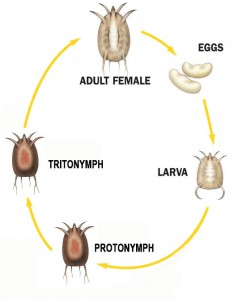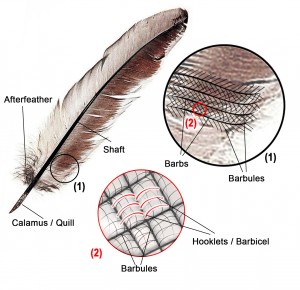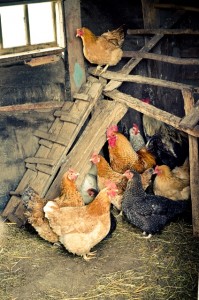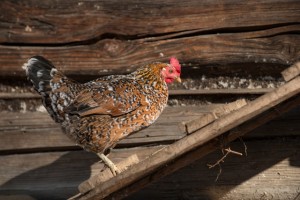Poultry Diseases
Poultry Mites
Includes the following conditions: Red mite (Dermanyssus gallinae), Northern Fowl Mite (Ornithonyssus sylvarium), Scaly Leg Mite
The red and northern fowl mites look quite similar, but there is a key distinguishable difference in their behaviour. The red mites spends much of its life cycle off the host; the adult and nymph only visiting birds to feed which is done mainly at night. These adult red mites can survive off host for many months. The northern fowl mite however, spends the entire life cycle on the bird and is only able to spend up to 10 days off host, much like most other poultry mites. These behavioural differences are important as they need to be considered when tackling disease and implementing control strategies.
Northern Fowl Mite
Other Mites
Control and Prevention
Treatment Options
Good Practice
Red Mites
Red mites are one of the most important ectoparasites affecting birds in all types of production system across the UK, Europe and the US. It is an obligatory blood-feeding mite of domestic poultry, fowl, pigeons and other wild birds. It is often found in birds who occupy old buildings as the mite does not live on the bird, but instead in the environment of the house. After obtaining a blood meal red mites spend most of their lives off the host, aggregated in cracks and crevices of buildings, walls and shelters where mating and reproduction occur (Chirico and Tauson, 2002). As a result, daytime inspection of the birds may not detect large populations of red mites. Red mites can sometimes be seen on eggs, or may even be seen on humans – for example when someone has been working in a heavily infested hen house.
Wild and domesticated flying birds, and turkeys are also natural hosts so this must be considered when tackling disease. Also red mites can be transmitted between farms via crates, egg trays and personnel.
Clinical Signs of Red Mite Infestation
Red mites feed on resting hens for a short blood meal (1-2 hours) mainly at night. They move quickly over skin and feathers and in severe infestations their blood-sucking activity causes irritation and anaemia. Also at high levels of infestation, attacks by the mite can cause increased stress to the birds and subsequently reduced egg production, weight loss and in severe cases, death (Kilpinen et al., 2005). Behavioural changes also occur such as increased self-grooming and head scratching during the day and night (Kilpinen et al., 2005). Newly hatched chicks suffering from a heavy infestation may die. Even low mite numbers can make laying hens reluctant to rest on perches or to enter mite-infested poultry houses (Steenberg and Kilpinen, 2014).
Poultry mites in general have also been implicated as vectors of several significant disease organisms such as E. Coli, chicken pox virus, Newcastle virus and fowl typhoid. The bacteria Erysipelothrix rhusiopathiae, which causes erysipelas in wild and domestic birds, as well as pigs and other mammals, has been isolated from the integument as well as from the interior of red mites, implying that the mite is a potential vector and may act as a reservoir for the disease (Chirico et al., 2003).
Red and northern fowl mites can even occasionally bite mammals, including humans, causing painful skin irritation (Taylor et al., 2007).
Red Mite Life Cycle

Parasitic mite life cycle. The red mite life cycle can be completed in as little as a week under optimal conditions, and the northern fowl mite can take anything from 5-12 days. The main difference between the 2 mite species is the female red mite lays her eggs off the host, and only the nymph and adult stages feed from the birds.
The life cycle can be completed in as little as 1 week, allowing huge populations to develop rapidly.
- The eggs are laid by the female mite in cracks and crevices in poultry houses 12 – 24 hours after their first blood meal
- Within 2 – 3 days and under warm conditions the eggs hatch into 6-legged larvae, which do not feed until after they have moulted
- They moult to become 8-legged protonymphs within 1 – 2 days
- These moult again to become tritonymphs again within 1 – 2 days
- Within a further 2 – 3 days they moult again to become adults
Stages 3 – 5 are feeding stages, and they only parasitise birds in darkness and blood-feed for 1-2 hours per night. However the adult the red mites can survive several months without feeding, allowing a reservoir population to survive in the hen houses.
Adapted from (Taylor et al., 2007).
Heavy infestation can result in a drop in egg production. Birds may refuse to lay in infested nests. A serious red mite problem can result in sudden mortality, anaemia and egg drop (Swarbrick, 1986)
The level of activity of red mites is a reflection of their physiological condition, levels of starvation, heat cues and the length of absence of a host. Activity declines following long periods in the absence of a host (Kilpinen and Mullens, 2004). Swedish researchers monitored mites with traps at monthly intervals over 4 years and they showed that mite populations took about five months from first detection to reach relatively stable levels around which they fluctuated. In their study mite populations were significantly denser in summer than in winter. Mite populations apparently adjust their behavioural pattern to the birds’ roosting behaviour (Nordenfors and Höglund, 2000).
A Defra-funded (then MAFF) research project “Monitoring of red mite habitat preference and distribution in a perchery egg production system” (Project AW0224) showed when the mite population is very large all areas of the house are used. This implies that the distance travelled by some mites to reach a blood meal can be quite considerable (ADAS, 2002).
Microscopic examination of the red mite reveals a V-shaped ventral anal plate compared with the oval plate of the northern fowl mite. Their mouthparts are also different.
The Northern Fowl Mite
Liponyssus (Ornithonyssus) sylvarium, the northern fowl mite, breeds continuously on the host bird. Eggs are normally laid in the cooler regions of the bird such as the vent area or on feather shafts. The mite then migrates to the neck. Eggs laid on feathers normally hatch within a day, with larval and nymph stages completed in four days and the entire life cycle within a week. The northern fowl mite is distinguished from the red mite by the fact that is present on birds in large numbers during the day (Taylor et al., 2007). This mite tends to be less of an issue in extensive, pasture based systems.
Clinical Signs of Northern Fowl Mite Infestation
Inspection can reveal heavy deposits of mite eggs and faeces in the vent area. On inspection of an infected bird, mites will rapidly crawl up the human arm. Parting of the feathers reveals the mite, eggs and excrement. The mites can also be seen crawling on eggs. The northern fowl mite is sometimes confused with the red mite, although, unlike the red mite, it can be found during daytime. Heavy infestations result in blackened feathers and scabby and cracked skin, particularly around the vent, and infested males can be discouraged from breeding.
The problem can increase during the winter, and drop to low numbers in hotter weather. Northern fowl mite can enter poultry flocks by means of new pullets, vehicles and bird crates, or be carried in by people or wild birds.
An acquired immune response of White Leghorn hens to populations of northern fowl mite has been recorded. The degree of acquired immunity was related to the initial level of mite infestation (DeVaney and Ziprin, 1980).
The Northern Fowl Mite Life Cycle

The depluming itch mites are embedded in the tissue at the base of the feather quills. These mites like all feathered areas of the bird including the head, neck, back abdomen and upper legs. The northern fowl mite is often found on the shaft of the feather in the vent area.
Unlike the red mite, the northern fowl mite cannot survive off host, it spends the entire life cycle on the bird.
- The adult female lays about 1 – 5 sticky to whitish eggs at the base of the feathers after a blood meal
- The eggs hatch in about 12 – 24 hours to produce 6-legged larvae
- These moult to become protonymphs
- The protonymphs feed, then moult again to become tritonymphs
- The tritonymphs do not feed and they moult to become adult mites
The entire life cycle takes 5 – 12 days under optimal conditions, but it usually takes longer.
The life cycle is adapted from (Taylor et al., 2007)
The virus that causes St Louis encephalitis and western equine encephalomyelitis have both been detected in the US and it is highly likely that the northern fowl mite acts as a vector for their transmission (Taylor et al., 2007). The northern fowl mite is also capable of transmitting fowlpox, Newcastle disease, and chlamydiosis.
Other Poultry Mites
Although the red and northern fowl mite are the most common, other mites can cause disease in poultry. The depluming itch mite (Knemidocoptes gallinae) is a burrowing mite that causes intense pain and irritation, causing the bird to pull its own feather loss and can stimulate cannibalism. Progressive feather loss and intense scratching is observed in infected birds. It is the only borrowing mite of poultry and clinical signs resemble sarcoptes infections. It is found in chickens, turkeys, pheasants and geese worldwide.
The scaly leg mite (Knemidokoptes mutans) affects mainly chickens and turkeys causing excessively scaly skin and deformed legs and feet, leading to lameness and distorted feet and claws. Occasionally the neck and comb are affected. Scaly leg mite gets on to the birds’ feet from the ground, and lives under the scales of the legs and is normally seen in older hens kept outdoors. Symptoms are irritable lesions covered with white flakes. Infected birds often stop feeding and eventually die.
Control and Prevention of Mites
Controlling mites is essential in maintaining the health, well-being and production efficiency of birds in commercial poultry units. Spraying poultry facilities with synthetic pesticides is currently the most commonly used control method, however the legislated withdrawal pesticides due to toxicity and environmental concerns has depleted the range of effective controls available to poultry farmers (Bartley, 2015). In addition to this there is evidence that the mites are developing resistance to some of the remaining products (Beugnet et al., 1997). An integrated control approach is needed.
A team of 18 Danish researchers and advisors in egg production identified the main risk factors for mite prevalence as:
- Poor house and furniture design
- Inadequate cleaning and disinfection
- Season, temperatures and humidity
- Delayed treatment (Hegelund and Sørensen, 2007)
The most effective form of control is through good management practices that focus on hygiene, vigilance and the provision of housing that does not encourage the proliferation of mites.
-
Poor house and furniture design
The movement from caged birds to enriched cages, free range and barn systems aims at improving the birds’ welfare, however it these conditions can also aid mite survival (Sparagano et al., 2009). Building design is a significant factor as red mites are known to breed profusely in the dark corners, cracks and crevices in particularly in old buildings.
Defra project AW0224 recommended the need to “design out” of poultry houses the perfect red mite refuges that are found at present in a typical UK barn system. The feeder and nest box systems that have metal and wooden structures have many unsealed joins and junctions, which are ideal red mite refuges, as with the furniture in enriched cages. Simple changes in the design of house furniture could help to control the problem such as the use of a silicon sealant in the folds and joints of house furniture is a simple, cheap and potentially effective control measure (ADAS, 2002).
In Swiss poultry systems, hygiene has been shown to have a large influence on the occurrence of red mite. The densities of red mite were higher in deep-litter systems than in systems where scratching area and dung storing facilities (dung pit or board) were separated (Maurer et al., 1993).
-
Inadequate cleaning and disinfection

Red mites are found in poultry houses in the day especially in cracks or where roost poles touch supports, or on the birds at night. This must be considered when implementing control measures.
Bad hygiene dramatically impacts on poultry mite populations (Sparagano et al., 2009). Poultry houses, equipment and surrounding outside areas should be disinfected between batches of birds. Particular attention should be paid to areas which make a good habitat for the red mite such as roof vents and nesting boxes. Once the house has been emptied and all manure is removed, thorough cleaning using a power washer or steam cleaner should be carried out. Any detachable internal fittings should be removed to enable effective cleaning.
Good sanitation will prevent the build-up of mite populations. If birds are introduced to a clean house, the level of mites is unlikely to build up to any significant effect during the lifetime of the flock. However, if there is carry over of infestation from one flock to the next, it will be a problem.
-
Season, temperature and humidity
Red mite populations tend to be higher in winter and lower in summer. However in Denmark and Italy, populations tend to be higher in late summer (Sparagano et al., 2009). Season is linked to temperature and humidity, researchers in Sweden found that mites do not thrive at low relative humidity, or at extreme temperatures (>45°C and at-20°C were found to be lethal) (Nordenfors et al., 1999). In the same study female red mites laid eggs at temperatures between 5 and 45°C with the highest numbers laid at 20°C and 70% RH, but development to larvae and protonymphs was only observed at temperatures ranging from 20 to 25°C (Nordenfors et al., 1999).
Depluming itch mite is particularly prevalent in spring and summer, and may disappear in autumn.
-
Delayed treatment
Frequent monitoring of mite infestation is important along with prompt localised treatment of mite hotspots in order to prevent mite infestation build-up. Mite populations can develop very rapidly under optimal conditions, so regular checks of the birds and buildings should prevent an outbreak, remembering that the red mite generally lives off host in cracks and crevices, and feeds at night. The northern fowl mite, depluming itch mite will be found in the vent area and on the feather shafts, and the scaly leg mite is predominantly on the legs and feet but can migrate up to the neck and comb.
Chemical Control of Mites
Mites can be controlled by the use of insecticide spray or dust to the birds and litter. They will not be eradicated – it is simply not possible to kill every mite in a single treatment. The key is to monitor the build up of the mite and if they get to levels where they cause problems, treat frequently over a short period of time to bring them back under control. Acaricides such as carbaryl and synergized pyrethroids can be used to treat buildings and equipment. Historically, the organophosphorus compounds, such as malathion and coumaphos, the carbamate carbaryl and pyrethroids were used. However due to serious safety concerns, organosphosphorus insecticides tend to be no longer used in the UK. This restriction can prove difficult when controlling a red mite problem, as resistance by red mites to pyrethroid chemicals has been recorded (Beugnet et al., 1997) and resistance to permethrin traps has been shown (Nordenfors et al., 2001).
It is important to use only compounds that are approved for poultry systems. Other, non-approved compounds may be effective, but can cause contamination of eggs and meat.
Biological Control of Mites
Various desiccant dusts, also known as inert dusts, are marketed for control of red mite in many European countries and are frequently relied upon as one of few available measures for poultry red mite control (Steenberg and Kilpinen, 2014). Dessicant dusts, also referred to as inert dusts often made up of natural substances such as powdered clay, and diatomaceous earth or synthetic products such as silica dust, although sometimes pure synthetic silica is used (Maurer and Perler, 2006). These products damage the mites epicuticle. Be aware that these dessicant dusts should not be breathed in as they can cause damage to the lungs.
The persistence of desiccant dusts in the field is often short-lived, however when used in combination entomopathogenic fungi Beauveria bassiana the levels of mite mortality were increased (Steenberg and Kilpinen, 2014). Another entomopathogenic fungi trialed in the lab and in the field against red mite is Metharhizium anisopliae. At high concentrations suspended in sunflower oil and sprayed onto hens and cages this fungi, administered did reduce red mite populations in commercial sheds (Tavassoli et al., 2011).
Beetles that live in poultry manure are used as a natural control of house flies in poultry houses (Axtell, 1986; Bills, 1973; Ceden et al., 1988; Hulley and Pfleiderer, 1988; Legner et al., 1975; Pfeiffer and Axtell, 1980), and there is also anecdotal evidence of good control of mites in poultry houses through the encouragement of the beetle (in chicken manure) as a natural predator however these findings have not been published in the literature.
A daytime refuge for red mite made of a cheap replaceable material (for example corrugated cardboard) could be installed in poultry houses, and removed and destroyed (incinerated) on a regular basis. Used in combination with the active designing out of red mite harbourages within the fabric of the building, and ‘baiting’ of the harbourages with a control agent (chemical, physical or biological) may be the control method of the future (ADAS, 2002).
Traps treated with the acaricide metriphonate can successfully reduce mite populations although placement near mite aggregation sites is essential for satisfactory control (Chirico and Tauson, 2002). Traps of 3mm thick corrugated cardboard of varying dimensions have been tested and those of dimensions 200x400mm may be feasible to use in non-chemical control programs. Smaller traps proved to be useful for monitoring purposes (Nordenfors and Chirico, 2001).
Monitoring programmes which continue through depopulation and clean-out, with traps positioned both inside and outside the poultry house, would provide useful information on red mite persistence within the house and possible mite migration in search of food. Monitoring should then continue into the subsequent flock placed within the house, in order to detect the first signs of red mite infestation (ADAS, 2002).
Other Mite Control Measures
“Baited” disposable artificial harbourages may provide a means of reducing total chemical use, or such harbourages may be used as a means of introduction of biological control agents into the barn in a controlled manner (ADAS, 2002).
Red mites can migrate in search of food when necessary, they also affect wild birds and game birds (Chauve, 1998) and so cleaning and treating the outside of poultry barns between flocks, or any shared spaces that wild birds can access is also an appropriate control strategy (ADAS, 2002).
An alternative control method is to warm the house and treat with a residual acaricide prior to repopulation. Warming the house mimics the presence of birds and thus attract to emerge from deep cracks and crevices (ADAS, 2002). Chemical control can then be applied.
Treating Mites

Treating individual birds (especially in the day time) with red mite infestation will not eliminate the mites, treating the buildings is more effective as this is where the red mites spend the majority of their time. However for other mite infestations such as northern fowl mite or depluming itch, individual birds will need treating as the mite spend almost 100% of their time on the host.
Treatment is normally aimed at attempting to eradicate a mite problem, and this may be achieved using insecticidal sprays or dusts. Cypermethrin (e.g., Barricade TM) is permitted under AWA and UK organic standards as a treatment.
Individual birds can be treated with by spraying or dusting the bird with an acaricide such as pyrethroid, however treatment in the case of red mite infestation should focus on treating the mite habitat in buildings and furniture (Taylor et al., 2007). Birds may also be treated with ivermectin or moxidectin, which although effective, may only act for short periods (Taylor et al., 2007). If there is a serious infestation, birds can be treated with ivermectin in water to help get it under control – it must be noted that eggs cannot be used for consumption during this treatment.
Birds with scaly leg mite can be treated by dipping legs in a bath containing HCH (Hexachlorocyclohexane 0.1%), sulphur solution 10%, or sodium fluoride (0.5%), oral or topical ivermectin may also be effective (Taylor et al., 2007).
Essential Oils Used in Treating Mites
The acaricidal activity of 56 plant essential oils against red mite. Jade, clove bud (Eugenia caryophyllata), coriander, horseradish and mustard oils were more effective in closed containers than in open ones, indicating that the effect of these essential oils was largely due to action in the vapour phase (Kim et al, 2004). A 92% reduction of red mite has been recorded using neem oil (a compound originating from the Azadirachta indica tree) in impregnated traps (azadirachtin) (Lundh et al., 2005). Carroll (1994) tested 18 naturally occurring compounds and plant extracts fed to poultry deterred northern fowl mites from feeding and reported that citronella and bay extracts prevented mite feeding at 0.1% concentrations. None of the 18 plant extracts tested had repellent properties (Carroll, 1994).
Another study reported that Lavender oil and Thyme oil extracts both had toxicity (Lavender 97% mortality) and repellent effects against the red mite (Nechita et al. 2015). Thymol, the main constituent of Thyme oil, also has a repellent effect against the rabbit ear mite Psoroptes cuniculi (Perrucci et al., 1995), suggesting that thyme oil could not only be used against red mite but also on other mites (Nechita et al., 2015).
Good Practice Based on Current Knowledge
- Differentiating between the presence of red mites and northern fowl mites is important as they require different approaches to control
- Control of red mites will involve targeting the birds environment, whereas the northern fowl mite requires chemical application to infested birds
- It is important to look for red mites at night in crevices, dark corners and cracked woodwork, nest boxes and rooster perches. They are evident as tiny red or blackish dots, clustered together.
- Good hygiene management consisting of thorough cleaning and disinfection of poultry houses between flocks and a break period of 10 days before repopulation and batches
- Red mites can survive off host for up to 34 weeks, so it is important that all corners of buildings, furniture and surrounding are cleaned between batches to avoid mite populations building up
- Poultry houses could be designed and maintained to avoid creating ideal habitats for red mites – sealing all joints and junctions with silicon is a cheap and effective control measure


 American English
American English

Comments are closed.